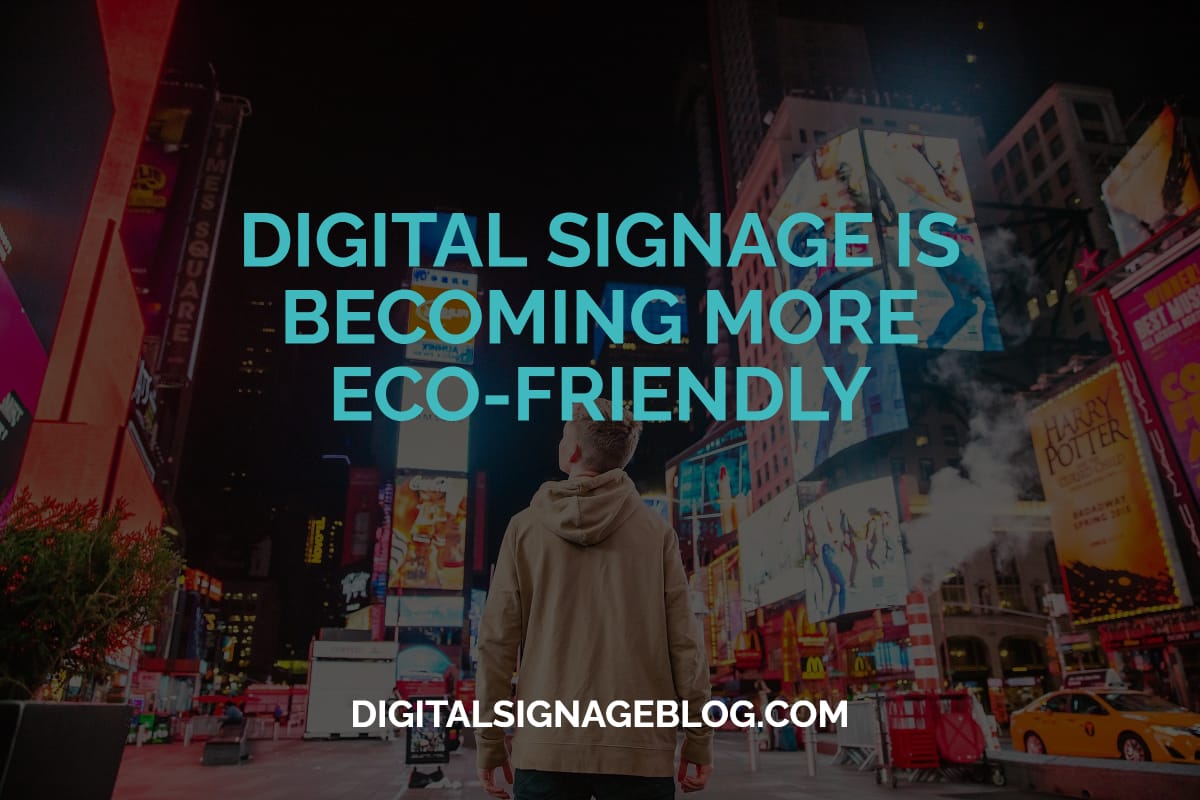News
DIGITAL SIGNAGE IS BECOMING MORE ECO-FRIENDLY

The use of digital signage is spreading fast. After a slow start, it is becoming widely adopted by retailers, public buildings, councils, transport hubs, and all kinds of businesses. These days, pretty much wherever you look you are going to see digital screens displaying information or advertising. The fact they are easy to read and carry up-to-date information is welcome by people. But a lot of those people are also worried that these screens are bad for the environment.
This is something that the suppliers of digital signage solutions are also concerned about. For that reason, they have been working hard to reduce the environmental impact of their products. In this article, we are going to take a look at what is happening within the industry and beyond and talk you through some of the improvements that have been made.
Paper vs digital
But, before we do that, let´s first look at the paper vs digital argument that has been raging for several years now. There is a tendency for people to automatically think that paper advertising is more environmentally friendly than using digital signage.

Recycling paper requires the use of electricity and water
Often, they forget to factor in the fact that recycling paper still consumes fuel, electricity, and water. According to Optiwee, it takes about 840 kWh to create a tonne of paper using recycled materials. Which is a lot better than the 1,400-kWh needed to produce a tonne of paper from trees. But it is still a huge amount of electricity.
Plus, that paper and cardboard have to be baled up and compacted, which also consumes power. The compactors are bulky and a lot of raw materials are needed to make one.
Making a tonne of recycled paper consumes around about 24 m3 of water. In addition, fuel is burnt by the recycling companies driving around to collect the bales of old posters and paper information signs. This also happens when the recycled paper is delivered to the print firm, and the finished posters, leaflets, and flyers are sent on to the customer.
That said, we must not lose sight of the fact that recycled paper is much, much more environmentally friendly than paper made from trees. You can read more about why that is here.
Both paper and digital signage have an environmental impact
However, we can still legitimately state that the environmental impact of using paper advertising and information sheets is substantial. Now, we are not saying for one moment that using digital signage does not have any impact. That is patently not true.
The materials to make the screens must be extracted and transported, which uses water, fuel, and electricity. Manufacturing them also uses power and fuel is burnt to deliver them to the customers. Plus, of course, while they are on, they are consuming electricity.
But over the past few years, the environmental footprint of making and using digital screens has been reduced. Read on to learn how.
The use of recycled materials to make digital display screens
Increasingly, the casings of these screens are made from recycled materials.
Screens last for many years
They are built to last. When, after many years of use, they break, it is often possible to repair them and continue to use them for many more years. However, in time, they will become impossible to repair and need to be replaced.

Modern screens are far easier to recycle
Fortunately, modern LED screens are far easier to recycle. Around 98% of the materials they are made from can be reused. Increasingly, firms are checking that this is the case before they buy their digital display monitors, and they are actively sending them for recycling.
Of course, just like with paper, recycling a screen consumes power, fuel, and some water. But this is only going to happen once every decade or so, per screen. With paper posters, you are talking about sending them to be recycled after just a week or a month´s use. Something you have to bear in mind when looking at the paper vs digital debate.
Modern screens use a lot less electricity
Of course, these screens still use electricity, which does have an environmental impact. But they use a lot less than they used to. When the team at Mandoe Media’s digital signage investigated this they discovered that the best modern digital display screens use 90% less power than older ones did.
The greater availability of green power sources
If that power comes from a green source the environmental impact of running the screen each day is very low. With businesses putting solar panels on their roofs and redirecting waste heat from things like fridges, running electrical items using green energy is becoming increasingly viable.
Whether digital signage is the green option does still depend on who is using it, where, and how. For example, a small barber shop that has no green electricity and never changes its list of cuts/prices or wants to advertise to its customers having a paper service list printed up is probably greener than using a screen. Especially if that list is going to stay in place for years. But, for a supermarket that puts up 40 new offer posters and changes them every week, using a few big screens that can easily be seen across the shop almost certainly is greener than sticking with paper.
There is no doubt that digital signage has become more environmentally friendly. As the industry evolves the aim is to become more so.
LIKE WHAT YOU'VE READ?
When you subscribe you will also join other Digital Signage readers who receive our content right in their mailbox. Good luck!






Comments (0)